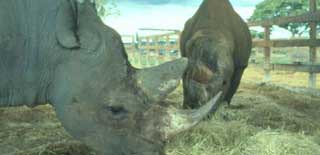Tuesday, April 29, 2008
Where have all the rhinos gone?
Do you like this story?
How has wildlife fared amid the political chaos of Zimbabwe?
Words and images: Stephen Mills
At Mana Pools National Park, in a lodge overlooking the Zambezi River, I am the only one here to listen to the cacophony of frogs in the water below and the groans of lions drifting out from the woods.
Tourism is grinding to a halt. About 85 per cent of the lodges in Hwange and Kariba have closed. The whole country is screwed up with tension, and everyone hopes that life will somehow begin anew after the apocalyptic election in March.
Lack of money not care
I've come to Mana Pools a fortnight after a tragedy. Early one morning, a park patrol ran into a gang of poachers and a gunfight ensued in which one of the park scouts, Dzvaka, was hit in the leg. The team's solar-powered radio transmitter didn't work until sunrise, wasting valuable time. The park's helicopter was grounded because of an unpaid bill, and none of the scouts had first-aid training. They hacked out of the bush, then drove three hours to Kariba hospital. Twenty minutes from town, Dzvaka died.
Zimbabwe and its National Park Service have much to be proud of. Numbers of black rhino, for example, are increasing yearly by 11-12 per cent from a low of 270 in 1993. Yet in every park I visit, there's now a palpable lack of confidence, little equipment and a scarcity of senior officials in the field: the same sort of hesitancy of which the death of Dzvaka was so symptomatic.
Private parklands
A second tier of official conservation is provided by the 'conservancies' - alliances of large, private farms which share their wild animals and the costs of policing them. But, in the current economic and political climate, such huge farms can no longer be held in so few hands. The presence of rhinos no longer provides protection for the owners. Of the four conservancies, two have already been taken over by war veterans, for whom, struggling to earn an unfamiliar living off the land, the animals are free dinners. One conservancy claims that 30,000 animals have already been snared there.
The truth is that nearly everyone in Zimbabwe wants to hunt the animals. To the conservancy farmers, wildlife has always been an asset to be paid for by tourists who want to see or shoot it. For farmer Peter Seymour-Smith, the argument is simple: "At the first whiff of trouble, the tourists vanish, but the hunters still come. We could auction a single hunt for $50,000 - that's a lot of money for conservation. Otherwise, the rhinos are finished. Wildlife cannot survive on charity for ever - sustainable utilisation is the way to ensure its future. A change of government won't reverse matters."
Unless the management of the national parks can be revived and the conservancies spared further fragmentation, much of this nation's wildlife will end up as a last supper.

This post was written by: Franklin Manuel
Franklin Manuel is a professional blogger, web designer and front end web developer. Follow him on Twitter



0 Responses to “Where have all the rhinos gone?”
Post a Comment